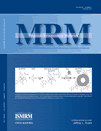A novel phase and frequency navigator for proton magnetic resonance spectroscopy using water-suppression cycling
Abstract
Magnetic resonance spectroscopy is sensitive to movements, in part, because of motion-induced phase and frequency variations that lead to incoherent averaging. For in vivo proton magnetic resonance spectroscopy, the unsuppressed or under-suppressed water signal can be used to restore coherent averaging; however, this approach results in baseline distortions due to the large water peak. Therefore, a novel water-suppression cycling scheme was developed that alternates between positive and negative residual water signal. Using the residual water signal, the method allows for shot-to-shot phase and frequency correction of individual free induction decays and restoration of signal losses due to incoherent averaging, yet near-complete elimination of residual water. It is demonstrated that the residual water signal can be used to restore metabolite peaks in a brain spectrum from a subject who performed intentional head movements. The ability to correct phase and frequency fluctuations during subject motion is vital for use with adaptive motion correction approaches that ensure proper voxel positioning during head movements. Magn Reson Med, 2010. © 2010 Wiley-Liss, Inc.




